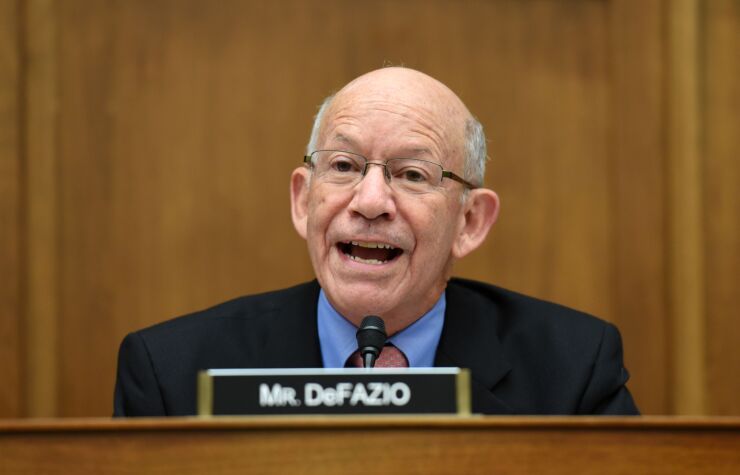Members of the House Transportation and Infrastructure Committee introduced a bipartisan bill authorizing $40 billion over five years for wastewater infrastructure through low-interest loans.
Committee chair Rep. Peter DeFazio, D-Ore., along with fellow committee members Reps. Grace Napolitano, D-Calif., and Brian Fitzpatrick, R-Pa., announced the Water Quality Protection and Job Creation Act of 2021 Tuesday. The bill would increase federal funds to states and municipalities through the Clean Water State Revolving Fund to $40 billion over five years and include $10 billion in grants.
“By reauthorizing the Clean Water State Revolving Fund for the first time in over three decades, we have an opportunity to invest in both rural and urban communities alike and ensure that no matter what zip code a person lives in, they will have access to clean, reliable, and safe water,” DeFazio said. “I look forward to getting this bill signed into law because clean water can’t wait.”

The fund has not had a multi-year reauthorization in decades and gets an annual appropriation of about $1.6 billion, which has remained steady over the past few years.
SRFs act as infrastructure banks by providing low-interest loans for drinking water infrastructure projects. As money is paid back into the state’s revolving loan fund, the state makes new loans for other projects. These recycled payments of loan principal and interest earnings allow the state’s fund to “revolve” over time.
The House T&I bill also gives $2.5 billion in wastewater infrastructure assistance to address the backlog of critical needs for Indian Tribes and authorizes an additional $2 billion in grants to municipalities to capture, treat, or reuse sewer overflows or stormwater.
The U.S. Chamber of Commerce and other groups supported the bill.
“This bipartisan legislation includes unprecedented funding for the Clean Water State Revolving Loan Fund and grants for treatment of emerging contaminants such as PFAS, among other provisions that will provide good-paying, technical jobs and ensure modern, resilient wastewater infrastructure across our nation,” said Marty Durbin, senior vice president for policy at the U.S. Chamber of Commerce.
Marion Gee, finance director at the Metropolitan St. Louis Sewer District, said he uses his state’s SRF funding “quite a bit” so additional money into the SRF is helpful.
There is not yet a Senate companion bill, but the Senate Environment and Public Works Committee is expected to introduce a similar bill, including drinking water funding, in the coming weeks. The EPW committee is holding a hearing Wednesday morning on drinking water and wastewater infrastructure projects.
The House is laying the groundwork for a larger infrastructure package, said Adam Pugh, associate legislative director at the National Association of Counties. Last week, the House Energy and Commerce Committee introduced the Leading Infrastructure for Tomorrow’s Act, or LIFT America Act. That was introduced by 32 Democratic members and includes $312 billion in clean energy, energy efficiency, drinking water, broadband and health care infrastructure investments. About $51 billion of that would go to drinking water SRFs.
The House T&I bill introduced Tuesday includes twice as much funding as similar legislation in the last Congress. That bill authorized $20 billion over five years in the CWSRF, but it was not considered in the Senate.
“Reading the tea leaves, watching the party switch in the Senate, I think the House is putting forward more aggressive language that could potentially be passed out of the Senate,” Pugh said. “Last year, they liked the odds of $20 billion passing through the Senate more than they did $40 billion. So this year, they’re aiming higher.”
The House T&I bill does not yet offer a way to pay for the funding. Sources say it’s likely it would be folded into an infrastructure bill.
A larger infrastructure bill may use the reconciliation process, where the Senate would just need a simple majority instead of 60 votes to pass legislation.
“We don’t have control of the congressional process,” said Jason Isakovic, director of legislative affairs at the National Association of Clean Water Agencies. “We hope that these pieces of legislation are included in any comprehensive bill in any form that provides the highest level of funding possible for clean water utilities, especially in the form of direct grants.”





